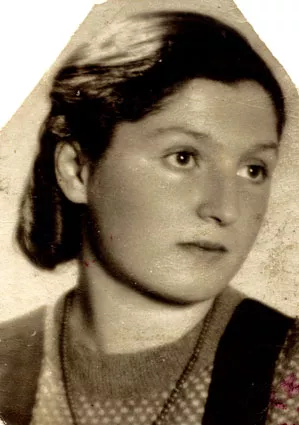This is me. This picture was taken during World War II. I don’t remember who took this picture, but it’s a studio portrait. It must have been taken in Warsaw.
A lot of people left Poland at the start of the war. But at the time my mother had absolutely no thought that that was what we should do. She thought: well, we can stay here! When the order came for the ghetto to be established, my mother had no doubt. She thought that that was what we had to do: go to the ghetto. She had no doubt. It's silly, but she had none. We moved to the house we had lived in before, on Pawia. And later on there was a German 'shop' there, Schulz's. As unskilled laborers we unpicked furs from donations in Germany. After that furriers would make them into gloves and hats for the soldiers. Those furs definitely weren't from requisitions in the ghetto, because by then no one had furs any longer. And so it was partly thanks to that that we survived, because we managed to get ourselves work in the 'shop.' And that's how we survived the period of the biggest transports.
In the ghetto I studied in the 'sets' of the Spojnia gymnasium. It wasn't particularly secret, because nobody was persecuting us, but it was a certain closed circle. A lot managed to escape from that circle, or at least attempted to. Some were killed later on, but they escaped [from the ghetto] however they could. The Jewish masses [religious Jews] had no chance. If you spoke only Yiddish or went around in a kaftan, you had no chance. There was no point in even trying in Warsaw.
There's a book by Henryk Grynberg: The Jewish War. It's a marvelous book. He shows through the eyes of a child what was going on in the countryside at that time. And I happen to know what was going on in the city, and I was fairly privileged, which I have even been reproached for. When a friend in Canada published my book, somebody said to her, 'Yes, but that lady was in an exceptional position.' I was! My parents' prewar circle at least tried to save itself. They didn't all succeed. But they had a chance because they were Polonized to a large extent.
After the second big campaign in February 1943, we escaped to the Aryan side, over a ladder, over the ghetto wall. You bought a crossing from smugglers. Unlike what some people think, it wasn't terribly expensive. You had to pay a group of smugglers, a Polish policeman, and a German. You got over to the other side and waited in a sentry box until dawn. Once you got out onto the Aryan side you had to sew a scrap of fur on quickly, so that it wouldn't be obvious that you were from the ghetto. From there we went straight to Zoliborz, to the wife and daughters of a friend of my father's from university, who was murdered at Katyn. I applied to Yad Vashem to have that family awarded a medal [Wladyslawa Sienenska and her daughters, Zosia and Janina]. They helped us the most. The most important was the first person you went to from the ghetto. After that our friends and family who had also gotten out of the ghetto helped us. We passed on from one family to another. Lucyna was with us in spirit; we couldn't live with her because she didn't have her own apartment.

















